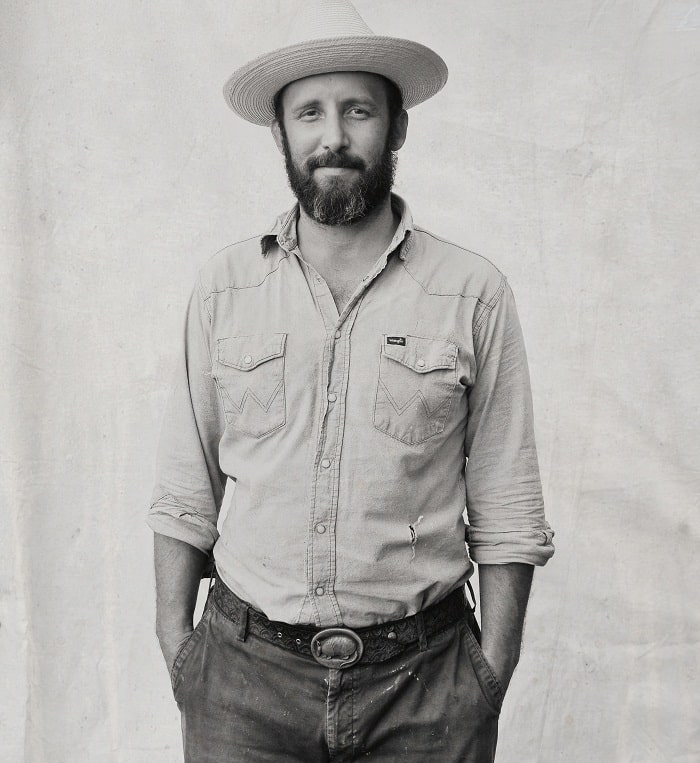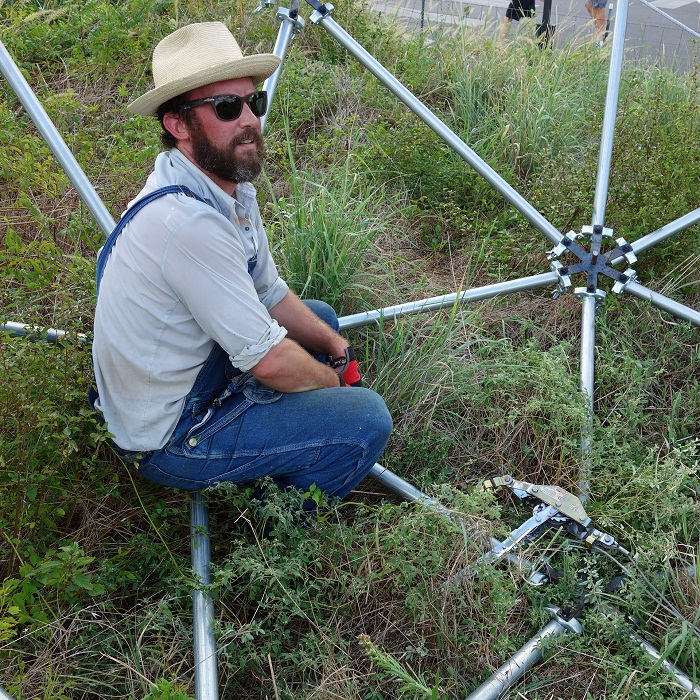
The artist, Jack Sanders (Credit: Stevan Alcala)
Guest article by Dana Sayre
Drawing Lines is a city-wide multi-media public arts project intended to foster discussion, connections and awareness around the recent restructuring of City Council districts here in Austin.
The project pairs an artist with each of the city’s newly drawn City Council districts to create a place-specific work. Drawing Lines examines culture’s role in the creation and transformation of a sense of place, as well as how to include the process of making art in conversations about Austin politics.
Constructing Art

Jack Sanders’ piece, Construction Event, can be viewed behind the Elisabet Ney Museum
Jack Sanders was the artist nominated for District 9. His piece, Construction Event, is a temporary sculpture placed behind the Elisabet Ney Museum in Hyde Park (304 East 44th Street). Sanders has lived in Austin with his family for the better part of a decade, after getting a master’s degree in Architecture from The University of Texas at Austin.
Sanders said he didn’t know much about Drawing Lines from the outset, but knew and respected a few individuals involved with it and was excited to participate. “My family had just moved from one district to another,” Sanders remembered. “This was an opportunity to get to know my district via an art project. I swim at Shipe Pool. I drink coffee at Quack’s at 43rd. We get our groceries at Fresh Plus. This is what my family and I dreamed of–to have these things accessible to us in this way.”
“To be able to connect with the Elisabet Ney Museum is special,” Sanders continued. “I didn’t know much about it. To get to know her and the people who work there and know her work, it grounds me. Ney was an artist in District 9 ‘keeping it weird’ in 1893. I feel good to be a part of that.”
Material World Meets Nature

The artist at work
“I was intrigued by the idea of employing traditional construction materials to create an object,” Sanders said. “I designed a large-scale sphere using metal scaffolding poles, cheeseborough clamps and hand tightened wing nuts. Nothing is fastened permanently, referencing both growth and the temporary nature of construction sites—such as the provisional structures made to enable construction projects, provide venues for music festivals and events, and signal temporary street closures and traffic detours.”
Sanders said part of the enjoyment he gets from working with temporary art is watching nature grow back up around it. Construction Event was lowered into the wildflowers behind the Elisabet Ney Museum by a crane from the City of Austin, so the project would have the least amount of impact on the native landscape. “Once you leave it alone for a week, that’s recovered,” Sanders explained. “It’s tougher than the lawns we create.”
Exhibit Viewing Details
Though the opening reception for Construction Event is Oct. 7 at 7 p.m., the piece was made available to be viewed by the public for free starting Sept. 30. As part of the process, Sanders will be available at the Elisabet Ney Museum every Wednesday evening at 7 p.m. for the duration of the project to answer questions, hear audience reactions, facilitate discussions and get community feedback about both his work and what it is like to live in District 9.
“There is a sign saying when I will be there to talk,” Sanders said. “Whether or not anybody cares is another thing. It won’t hurt my feelings.” Sanders said he is open to criticism as well as positive feedback, and believes both are an important part of the artistic process.
“I can handle it,” Sanders reassured me in our interview, saying that he’s used to people having a variety of reactions to art made from construction materials. Sanders worked on a similar project on a traffic median in Virginia. “Traffic stopped on both sides,” he remembered. “Some people got it was an art project. Other people would yell.”
Speaking about his piece for Drawing Lines, Sanders said, “I don’t know if I have an expectation. I’m more interested in hearing from people. I probably have good and bad feelings about both the event economy and construction economy in Austin and this is an expression of my feelings about that. If people want to talk, I’ll do my best to talk about it.”
The Artistic Process
More creativity than we can fit in one frame. Meet your artists! #DrawingLinesATX pic.twitter.com/q18v0BdTZ0
— Drawing Lines (@drawinglinesatx) March 25, 2015
Sanders said the artists for Drawing Lines were given a lot of autonomy regarding the way they chose to go about creating pieces for the project. Sanders had been interested in creating a piece like Construction Event for a few years, and took the opportunity. Other artists developed musical arrangements, videos or more permanent constructions or murals.
The artists were also given the opportunity to meet each other and discuss their artistic processes, exchanging ideas and support throughout the process. Whatever each artist chose to create for Drawing Lines, it was meant to be both representative of their response to the unique culture of their particular district and to encourage active participation from community members.
“It represents the diversity of the districts. There are so many ways the project is being handled. It’s about giving a voice to as many people as possible,” Sanders explained, “including people who didn’t have a voice.”
For the Love of Creativity
Here’s to doing what we love. #DrawingLinesATX pic.twitter.com/g8wa7vCpOS — Drawing Lines (@drawinglinesatx) October 2, 2015
Each of the projects for Drawing Lines will be available over the course of the next few months, with opening receptions staggered throughout. More information is available on the Drawing Lines website.
“Somebody’s asking me to be an artist in relation to our city and city government,” Sanders said. “That our city would participate in this conversation with me is really cool….I hope people have strong reactions in both directions,” Sanders said of Construction Event. If someone really has a problem with it, I hope someone else tells me it made their day.”
The sculpture piece will be available for the public to view until Nov. 15.
To learn more about Sanders’ previous work, visit his website.
@theAustinot wants to know:
What’s your favorite piece of public art in Austin?
Dana Sayre is a freelance writer and Austinite. More of her writing, focused on issues of gender, sexuality, mental health and social justice, can be found on her website.
- Best Austin Restaurants With a View – 8 Most Scenic Places to Eat - October 8, 2022
- 7 Best Austin Restaurants With a View: Most Scenic Places to Eat - October 21, 2021
- DipDipDip Tatsu-ya Is Making Austin Go Wild Over Shabu Shabu - January 27, 2020

Leave a Reply
You must be logged in to post a comment.